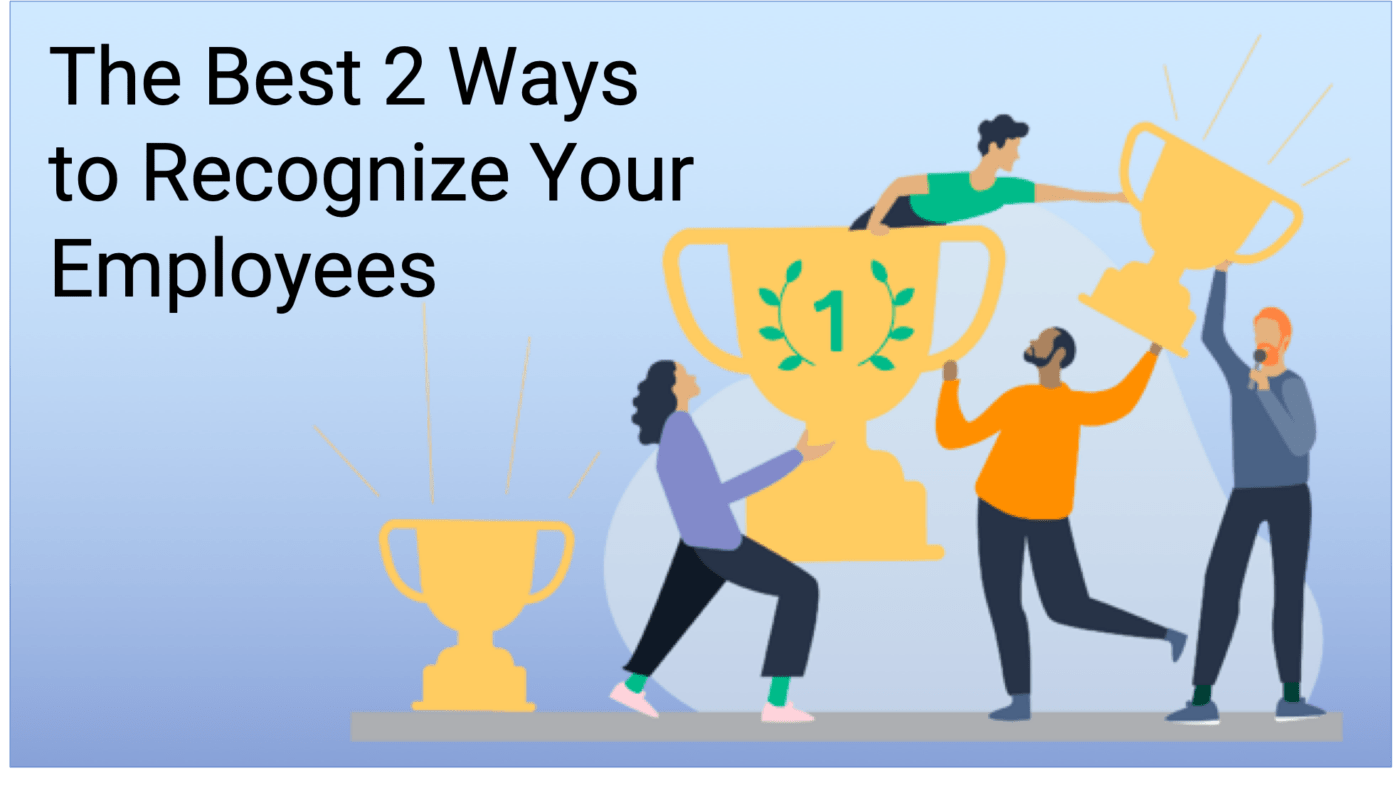Best 2 Ways to Recognize Your Employees
A lack of recognition is jeopardizing your business. If you don’t believe me, look at what research and statistics reveal:
Facts About Employee Recognition
- “The number-one reason most Americans leave their jobs is that they don’t feel appreciated. In fact, 65% of people surveyed said they got no recognition for good work last year.” (Gallup, Tom Rath and Donald Clifton, How Full Is Your Bucket? Positive Strategies for Work and Life, 2001)
- Only 1 in 3 workers in the US strongly agree that they received recognition or praise for doing good work in the past seven days. (Gallup, Employee Recognition: Low Cost, High Impact)
- “Only 14% of organizations provide managers with the necessary tools for rewards and recognition.” (Aberdeen Group, The Power of Employee Recognition, 2013)
- While the majority of organizations have a recognition program, only half of employees know about the recognition program. (Bersin by Deloitte, The State of Employee Recognition, 2012)
Research calls attention to the importance of recognizing your employees. It is a top 5 driver of employee engagement; it significantly improves employee retention; and it is a key criteria when hiring top talent. If you combine all these benefits of employee recognition, the impact on your company can be staggering. Research has found that companies that have a culture of recognition perform 12 times better than companies who don’t prioritize employee recognition.
Unfortunately, when leaders think about recognition in their organization, they tend to focus on the wrong things. Some believe that money or gifts are what encourage most people. Others become infatuated with a new program or software that allows everyone in the company to acknowledge each other. Money, gifts, and new recognition software are all helpful, but research shows the best ways to recognize your employees are through 2 simple things: positive feedback and public recognition.
Best 2 Ways to Recognize Your Employees
Rule 1 – Give Positive Feedback in Private

The simplest but most effective kind of recognition is when a leader highlights the specific behaviors and accomplishments of an employee. You don’t need a fancy software system that will send the person a note, nor do you need an employee of the month plaque with corresponding parking space. All you need to do is pull the employee aside and provide positive feedback.
We recommend this simple 5-step feedback method to give honest, direct, and helpful feedback that recognizes your employee’s contributions. A more detailed article on these 5 steps can be found here.
1) What
The first thing you need to tell them is “what” exactly happened. Focus on objective things the person did, and what specifically they accomplished. This is your opportunity to highlight exactly what behaviors you want the other person to keep doing. And as much as possible avoid generalities. For example it is better to say, “Last week I noticed you helped a customer solve a really difficult problem for them,” instead of “You are really great with our customers.”
2) So What
But just identifying the “what” isn’t enough. You need to explain the positive consequences of that action. How did their actions or accomplishments benefit the team, the organization, or the customers? The key thing to remember is that the other person needs to see these consequences as important. If they don’t care about the stock price increasing, don’t make this point the foundation of your recognition.
3) Why
After highlighting the impact their actions have made, it is important to open a dialogue with the other person. And since recognition and positive feedback are about recognizing notable behaviors you want the other person to repeat, we recommend asking them about why they did what they did. By helping the person reflect on why they did such great things, you are helping them identify specific actions and mindsets that they will want to do again.
4) Now What
If you have done a good job explaining the positive impact of their actions and have dug into the root causes of why they did them, then the 4th step is easy. This is when you ask questions to help the person figure out how to do more of the positive things they did. Maybe this means sharing their learnings with the rest of the team. Maybe it means taking a new project or new responsibilities. Or maybe it just means trying to do it again the next time they face the same situation.
5) What’s Next
In the end, you both need to come to an agreement on the next steps you both will take. Don’t be surprised if you are asked to support them in continuing their positive actions, but by continuing to invest in them you are guaranteed to motivate them to perform at a high level.
Best 2 Ways to Recognize Your Employees
Rule 2 – Publicly Recognize the Person

While 1-on-1 recognition is critical, often a person does something so outstanding that you want others to learn from them. So while the first step is to recognize the person in private, we also recommend recognizing the person in front of their team (or the larger organization). That being said, not everyone is comfortable with public recognition, and that is why we always recommend asking the person’s permission to share it with the larger audience.
Public recognition is very similar to providing positive feedback to the person, but ultimately the biggest difference is that feedback is a dialogue between you and the other person, while public recognition is not. So instead of 5 steps, we recommend you use these 3 steps to publicly recognize the person.
1) What
For public recognition, begin by focusing on what specifically the person did that you want others to know about. The key thing is to focus on some specific behaviors, not a huge laundry list of everything the person did. What are the specific actions or accomplishments the person performed that other people should know about?
2) So What
Just like with feedback, once you describe what the person did, you need to explain the impact of the person’s actions on the team, the project, the organization, or the customers. The trap most people fall into is to downplay the effects, or to assume that the audience already knows about these. Instead, make sure you describe the impact in a clear and easily understood way that the audience will appreciate.
3) How Others Can Apply
The final stage of public recognition is to call out how you want to see others following in this person’s footsteps. You don’t need to be super explicit and say “I want you all to do exactly what this person has done.” But you should make it clear that this person’s behaviors / accomplishments are actions that others can emulate. I always suggest tying it back to the strategy, the culture, or the values of the company. For example, it can be as simple as saying, “Mia going above and beyond to help her customer is a perfect example of our company’s ‘User’s First’ core value, and that is something we can all learn from.”
Best 2 Ways to Recognize Your Employees
Employee Recognition Should Focus on What’s Important

By now, I hope you understand the importance of employee recognition, and can see how 2 simple actions from leaders can help your employees feel their contributions are acknowledged. But the biggest question remaining is WHAT you should recognize. Unfortunately, too many companies focus on recognizing the wrong criteria. For example, the majority of companies’ recognition programs recognize employee tenure. Just because a person stays employed at your company doesn’t mean that person actively contributes to the company’s success.
The real focus of any recognition initiative should be on behaviors and accomplishments that can either be directly linked to the strategy / mission of the company or more importantly, to the company’s values. Achieving results is one thing, but we cannot ignore ‘how’ those results were achieved. So be on the lookout for behaviors or actions that live up to your desired culture. If your company fundamentally believes in putting its users first, then every time you see someone put their users first, you need to recognize that person (both privately and publicly). In this way, recognition becomes one of the strongest tools to strengthen your culture.
Best 2 Ways to Recognize Your Employees

Leave a Reply